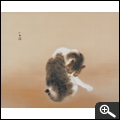
The Yamatane Museum of Art, Japan’s first museum to specialize in Nihonga, opened in July of 1966 in the Kabutocho neighborhood of Nihonbashi, Tokyo. Its core collection consists of a large group of paintings donated by the museum’s founder, Taneji Yamazaki (1893-1983). Its second director, Tomiji Yamazaki (1925- ), broadened and deepened the collection, acquiring works by Hayami Gyoshu and initiating programs such as the Yamatane Museum of Art Award.
On October 1, 2009, the museum moved to its new home in Hiroo, in Tokyo’s Shibuya Ward. Here, acting on our founder’s principle of contributing through art to society and, above all, culture, the mission of the museum is collecting, presenting and interpreting Japanese art through exhibitions and research on modern and contemporary Nihonga. To present the works in our collection as effectively as possible, our new facility incorporates the latest advances in lighting, display cases, and other equipment. It is our hope that, through the museum experience, visitors will develop an intense appreciation of Nihonga’s characteristic sense of the seasons and of the distinctive materials such as mineral pigments, silk, and paper used to create these paintings.
Hiroo, a neighborhood that is remarkably verdant for its city center location, is home to many schools, embassies, and other international institutions. The museum emphasizes educational and outreach activities that are a good match for its setting, including lectures for children as well as adults and special viewings on days when the museum is closed. Our goal, as a vital center for communicating information about Japanese culture both within Japan and internationally, is to to contribute to the advancement of scholarship and to society through exhibitions backed by systematic and steady research. We hope that our visitors will appreciate and support these efforts.
Regarding art as a part of life, the museum also offers fine art gifts inspired by the exhibitions and the changing seasons in the museum shop, together with a menu of special Japanese confections (wagashi) in the café. We hope that visitors will feel at home in our museum, develop a strong connection to it, and come to visit it frequently. We will be most pleased if, through their encounters with Nihonga at this museum, visitors not only enjoy a richly rewarding experience but also rediscover Japanese culture.
We look forward to welcoming you to the Yamatane Museum of Art.
Director
Yamatane Museum of Art
Yamatane Museum of Art was founded in 1966 by Taneji Yamazaki who has donated his numerous collection of Japanese art. The ex-chairman of the Yamatane Art Foundation, Tomiji Yamazaki collected 105 works of Hayami Gyoshu known as one of the most respected Japanese artists among scholars and collectors.
The Museum displays 6 to 7 exhibitions throughout the year by selecting paintings according to the respective topics. The collection mainly focuses on Kindai Nihonga (Modern Japanese paintings after Meiji era). The Museum also has collections of oil paintings, Ukiyoe, and Ancient Japanese Calligraphy. The wide variety and the level of the collection has a very high reputation among experts in Japan.
In 2007, as we faced the 40th anniversary, we staged the exhibition of “The Best Selection of Yamatane Museum of Art” from April 12 to July 16 (First Term Apr. 12-Jun.3, Second Term Jun.6-Jul.16). In this exhibition we displayed works of the Japanese-painting masters such as Yokoyama Taikan, Kobayashi Kokei, Hayami Gyoshu, Murakami Kagaku, Uemura Shōen, Okumura Togyu, Higashiyama Kaii, Kayama Matazo etc. The collection has many splendid paintings and a few of them has been designated as Important Cultural Properties which happens to be very rare for modern Japanese paintings.
The Museum does not exhibit the collection on permanent basis, due to the weak nature of Nihonga being easily affected by the environment. Paintings are replaced about 7-8 times a year based on respective topics to allow visitors to see as many collections as possible each year.
Please visit our museum and make your first step into the magnificent world of Nihonga.
| 3-12-36 Hiroo, Shibuya-ku, Tokyo 150-0012, Tel: 03-5777-8600 (Hello Dial, English available) |
|
| 10:00 a.m. - 5:00 p.m. (Last Admission at 4:30 p.m.) | |
| Mondays (closed on the day after a national holiday), December 28 - January 4, and closed for exhibition installations. Call to confirm schedules. | |
| Regular Exhibitions: Adults: 1,000 [800] yen, University and high school students: 800 [700] yen *Special Exhibitions: addmission fees vary according to each exhibition. Middle school and younger children: free of charge *Figures in brackets are for groups of 20 or more. *Disability ID Holders and one person accompanying them are admitted free of charge. |
|

The Museum has a collection of over 1800 works including four Important Cultural Properties which is very rare for modern Japanese paintings. They include Hayami Gyoshu’s "Dancing in the Flames", "Falling Camellias", Takeuchi Seiho’s "Tabby Cat" and Tsubaki Chinzan’s "View of Mt. Kuno", and 18 Important Art Objects such as Iwasa Matabei’s "Court Lady Enjoying Wayside Chrisanthemums" and Sakai Houitsu’s "Autumn Plants and Quails", which are special works of Edo Period and other masterpieces.
The museum's collection is also well known for the number of works by Okumura Togyu, such as "Maelsroms in Naruto" and "Cherry Blossoms at Daigoji Temple", Yokoyama Taikan’s "Sakuemon’s House", Kobayashi Kokei’s "Scenes from the Tale of Kiyohime", Uemura Shōen’s "Scene from a Noh Play Kinuta" and Murakami Kagaku’s "Woman in the Nude".
click thumbnail to enlarge
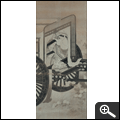 Iwasa Matabei
Iwasa Matabei
"Court Lady Enjoying Wayside Chrysanthemums"
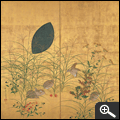 Sakai Houitsu
Sakai Houitsu
"Autumn Plants and Quails"
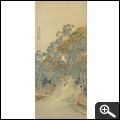 Tsubaki Chinzan
Tsubaki Chinzan
"View of Mt. Kunozan"
(Important Cultural Property)
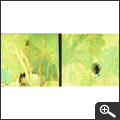 Yokoyama Taikan
Yokoyama Taikan
"Sakuemon’s House"
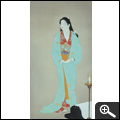 Uemura Shōen
Uemura Shōen
"Scene from a Noh Play Kinuta"
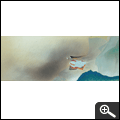 Kobayashi Kokei
Kobayashi Kokei
"Scenes from the Tale of Kiyohime"
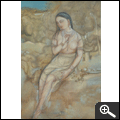 Murakami Kagaku
Murakami Kagaku
"Woman in the Nude"
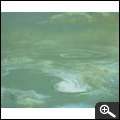 Okumura Togyu
Okumura Togyu
"Naruto Maelstroms"
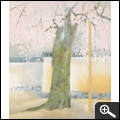 Okumura Togyu
Okumura Togyu
"Cherry Blossoms at Daigo-ji Temple"
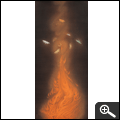 Hayami Gyoshu
Hayami Gyoshu
"Dancing in the Flames"
(Important Cultural Property)
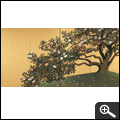 Hayami Gyoshu
Hayami Gyoshu
"Camellia Petals Scattering"
(Important Cultural Property)
| Exhibition | Periods |
| In 2011 | |
| A Profusion of Flowers -Painting the Four Seasons |
27 Apr – 5 June *5/2 ,5/6 open |
| Scenes of Primordial Beauty in Japan: Kawai Gyokudō, Okuda Gensō, and Higashiyama Kaii Depict Japan |
11 June – 24 July |
| Summer Vacation Event: Nihon-ga Zoo-An Animal Paradise |
30 Jul – 11 Sep |
| Special Exhibition Masterpieces of the Kabuki-za Theater Collection |
17 Sep – 6 Nov |
| The Best of the Yamatane Collection – A Special Exhibition Commemorating the 45th Anniversary of the Yamatane Museum of Art– |
1st rotation: 12 Nov – 25 Dec 2nd rotation: 3 Jan, 2012 – 5 Feb |
| In Japanese Garb: Uemura Shōen, Kaburaki Kiyokata, and Itō Shinsui |
11 Feb – 25 Mar |
* The above schedule is subject to change. Please visit our web site
www.yamatane-museum.or.jp or call Hello Dial, the general museum information
number, 03-5777-8600, for up-to-date information before your visit.
A Profusion of Flowers
—Painting the Four Seasons
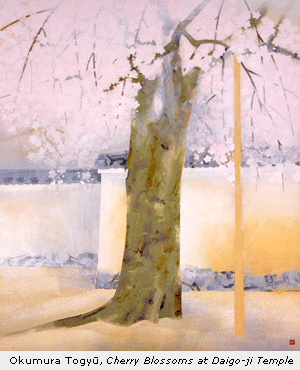
27 April (Wed.) – 5 June (Sun.) (Closed on Mondays except for 2 May)
Organized by: Yamatane Museum of Art and The Asahi Shimbun
Hours: 10:00 – 17:00 (Last admission at 16:30)
Admission Fees: Adults: 1,000 [800] yen,
University and high school students: 800 [700] yen,
Middle school and younger children: free of charge
*Figures in brackets are for groups of 20 or more.
*Disability ID Holders, with one person accompanying them are admitted free of charge.
Highlights of the Exhibition
- Sakai Hōitsu, Chrysanthemums with Bird, Color on silk, Late Edo Period, c. 1823–28
- Suzuki Kiitsu, Birds and Flowers of the Four Seasons, Color and gold leaf on paper, Late Edo Period, Mid 19th century
- Tanomura Choku’nyū, Hundreds of Flowers in Bloom, Color on silk, Meiji Period, 1869
- Araki Jippo, Birds and Flowers of Four Seasons, Color on silk, Taishō Period, 1917
- Kobayashi Kokei, Bird and Evergreen Magnolia, Color on silk, Shōwa Period, 1935
- Kobayashi Kokei, Irises, Color on paper, Shōwa Period, 1952
- Okumura Togyū, Cherry Blossoms at Daigo-ji Temple, Color on paper, Shōwa Period, 1972
- Fukuda Heihachirō, Peonies in Bloom, Color on silk, Taishō Period, 1924
- Fukuda Heihachirō, Poppies, Color on paper, Shōwa Period, c. 1940
- Yamaguchi Hōshun, Sunny Moments in the Rainy Season, Color on paper, Shōwa Period, 1966
- Hayami Gyoshū, Camellias, Color on paper, Shōwa Period, 1933
- Hayami Gyoshū, Black Peonies, Ink and color on paper, Shōwa Period, 1934
- Hashimoto Meiji, Cherry Tree in Morning Sun, Color on paper, Shōwa Period, 1970
For centuries, the Japanese have particularly enjoyed the various flowers of the changing seasons, celebrating them in poetry and depicting their beautiful images in paintings and decorative arts. The modern period saw artists continuing the long tradition of painting refined images of birds and flowers, and grasses and flowers, while at the same time striving to depict flowers with a new and modern sensibility which led to the creation of richly individualistic works.
This exhibition focuses on modern painting, presenting approximately 50 works ranging from late Edo period artists, such as Sakai Hōitsu, to those who were active into the beginning of the Heisei era, such as Uemura Shōkō. Featured works include: Okumura Togyū’s Cherry Blossoms at Daigo-ji Temple, with its gently expressed palette of cherry blossoms; Fukuda Heihachirō’s Peonies in Bloom, with its ethereal sensibility created through pigments applied to the back of the painting silk; Sakai Hōitsu’s Chrysanthemums with Bird, with its strikingly decorative tone and use of the Rimpa school’s tarashikomi ink puddling methods; and Hayami Gyoshū’s Camellias, depicting a single branch of blossoms caught in a moment of form and color. These paintings all reveal the colorful competition of flowers during spring, summer, autumn and into winter. We hope that visitors will enjoy this abundant display of artistic creativity as expressed in each painter’s own unique vision of floral beauty.
This exhibition provides visitors with an opportunity to enjoy the changing flowers of the seasons, to re-engage with the seasonal sensibilities, something too often overlooked in this fast-paced contemporary world, and to refine their individual approach to natural beauty.
 Sakai Hōitsu, Chrysanthemums with Bird |
 Fukuda Heihachirō, Peonies in Bloom |
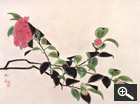 Hayami Gyoshū, Camellias |
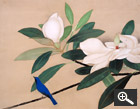 Kobayashi Kokei, Bird and Evergreen Magnolia |





